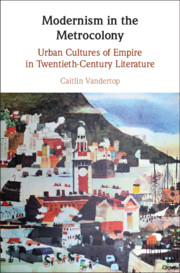Book contents
- Modernism in the Metrocolony
- Modernism in the Metrocolony
- Copyright page
- Contents
- Acknowledgements
- Introduction The Colonies in Concrete
- Chapter 1 Metrocolonial Modernism
- Chapter 2 Architectures of Free Trade in Conrad’s Singapore
- Chapter 3 Synchronising Empire Time in Joyce’s Dublin
- Chapter 4 Anglo-Indian Crises of Development
- Chapter 5 Ecologies of Empire in Oceanian Modernism
- Conclusion Mega-Dublins
- Notes
- Bibliography
- Index
Chapter 4 - Anglo-Indian Crises of Development
Published online by Cambridge University Press: 05 November 2020
- Modernism in the Metrocolony
- Modernism in the Metrocolony
- Copyright page
- Contents
- Acknowledgements
- Introduction The Colonies in Concrete
- Chapter 1 Metrocolonial Modernism
- Chapter 2 Architectures of Free Trade in Conrad’s Singapore
- Chapter 3 Synchronising Empire Time in Joyce’s Dublin
- Chapter 4 Anglo-Indian Crises of Development
- Chapter 5 Ecologies of Empire in Oceanian Modernism
- Conclusion Mega-Dublins
- Notes
- Bibliography
- Index
Summary
This chapter examines the 1930s urban fiction of Mulk Raj Anand, who adopts a self-avowedly Joycean emphasis on local specificity and engages critically with the Indian cities imagined by contemporaries including Rudyard Kipling, Aldous Huxley and E. M. Forster. If the city in Forster’s A Passage to India affirms a sense of the text’s spatial and narrative limits, Anand’s detailed representation of Bombay in his novel Coolie (1936) – which follows the short life of a worker who migrates to the port city – enacts a shift away from this emphasis on unknowable cultural divides, presenting difference as integral to the organisation of the metrocolonial economy. Showing how this subverts the narrative of ‘imperial maturity’ central to the city’s colonial identity, the chapter aligns Anand’s writing with other modernist fictions from metrocolonial zones.
- Type
- Chapter
- Information
- Modernism in the MetrocolonyUrban Cultures of Empire in Twentieth-Century Literature, pp. 95 - 119Publisher: Cambridge University PressPrint publication year: 2020

